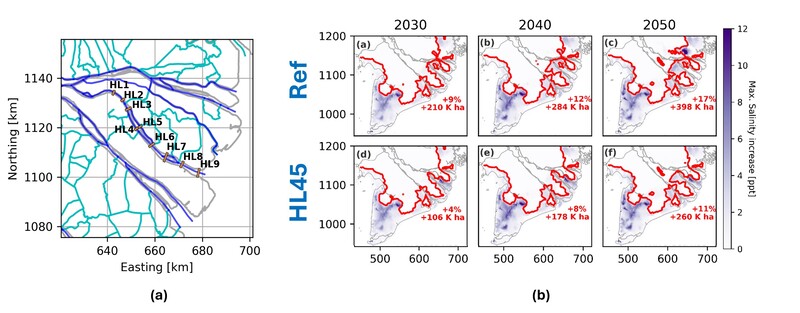L.E. Avila Ruiz2, S. Eslami1, T.S.D. O'Mahoney1, H.J.H. Clercx2
1 Eindhoven University of Technology, The Netherlands; 2 Deltares, The Netherlands
* Corresponding author: lucero_a.ruiz@hotmail.com
Introduction
In the face of climate change, deltas worldwide also face grave challenges in elevation loss, fluvial sediment decline and erosion, salt intrusion, and flooding (Vorosmarty et al., 2003) (Best, 2018). Salt intrusion is a natural process in deltas, but the increasing trends can significantly alter freshwater supply, food and job security and livelihoods, as it affects the freshwater supply by diminishing the availability and quality of source water for drinking and agricultural purposes. This is the case for the Mekong Delta, which has experienced a significant increase in salinity in the last two decades, mainly associated with riverbed erosion due to fluvial sediment decline and sand mining (Eslami et al., 2021). This heightens the necessity for mitigation measures to address the saltwater intrusion in deltas. With the Mekong River dividing into many distributary channels before draining into the sea, the Mekong Delta transforms into a multi-channel estuarine system. Studies into the potential effectiveness of mitigation measures in deltas that can be considered multi-channel estuaries is scarce, emphasizing the importance of this study.
Objective and Methods
This study examines the effect of a potential estuarine channel closure, its effectiveness and potential hydrodynamic impacts on the multi-channel estuarine system, while reducing and mitigating excessive saline water intrusion. The study utilizes a state-of-the-art Delft3D-FM numerical model of the Vietnamese Mekong delta (VMD) and the coastal region, with a network made up of both 2DV (widthintegrated but depth-varying) and 3D (three-dimensional) unstructured grids to model the flow (Eslami et al., 2021). To mitigate the salt intrusion in the VMD, the model incorporates dams along the Ham Luong channel, which is a single branch in a multi-channel system dealing with a rapid increase in salinity (Eslami, Hoekstra, Nam, et al., 2019). The incorporated structures are high enough, such that no flow exchange occurs within the branch of placement. The salt intrusion in the delta is determined by calculating the distance that saltwater is able to penetrate in each branch forming the VMD. At the same time, the flow division in the delta is determined using the subtidal cumulative discharge and averaging it over the running period (Eslami, Hoekstra, Kernkamp, et al., 2019).
Results
The results showed an intriguing impact of a closure in the multi-channel estuarine system. While it can block salt intrusion in the closed channel, its impact on the overall intrusion in the delta is sensitive to the location of the closure. The flow division in the delta also changes as a result of this structural solution, since more river discharge is re-directed towards the other non-closed branches, which in turn affect the vertical salinity distribution in the other branches, in some instances leading to more stratification. This means that the salinity response to the integration of the closure is more complex as the alongshore salinity is also influenced by the closure location. All in all, the complex interaction of the multi-channel estuarine system with the coastal sea suggests that studying these kind of structural solutions does demand complex modeling approaches that do integrate interaction between upstream, downstream and coastal seas in sufficient detail and in 3D to represent various salt transport mechanisms.

Figure 1a: Closures placed along the Ham Luong branch. Figure 1b: Future projections of the VMD under moderate anthropogenic stresses with closure (HL4 and HL5) and without closure (Ref) for which the increase in salinity-affected areas with respect to the reference case is determined by giving the increase in percentages and the increase in thousand hectares (K ha).
References
Best, J. (2018, 12). Anthropogenic stresses on the world’s big rivers. Nature Geoscience, 12 . doi: 10.1038/s41561-018-0262-x
Eslami, S., Hoekstra, P., Kernkamp, H., Nguyen Trung, N., Do Duc, D., Tran Quang, T., . . . van der Vegt, M. (2019). Flow division dynamics in the mekong delta: Application of a 1d-2d coupled model. Water , 11 (4). doi: 10.3390/w11040837
Eslami, S., Hoekstra, P., Kernkamp, H. W. J., Nguyen Trung, N., Do Duc, D., Nguyen Nghia, H., . . . van der Vegt, M. (2021). Dynamics of salt intrusion in the mekong delta: results of field observations and integrated coastal-inland modelling. Earth Surface Dynamics, 9 (4), 953-976. doi: 10.5194/esurf-9-953-2021
Eslami, S., Hoekstra, P., Nam, N. T., Kantoush, S., Binh, D., Dung, D., . . . van der Vegt, M. (2019, 12). Tidal amplification and salt intrusion in the mekong delta driven by anthropogenic sediment starvation. Scientific Reports, 9 , 18746. doi: 10.1038/s41598-019-55018-9
Vorosmarty, C. J., Meybeck, M., Fekete, B., Sharma, K., Green, P., & Syvitski, J. P. M. (2003). Anthropogenic sediment retention: major global impact from registered river impoundments. Global and Planetary Change, 39 (1), 169-190. (The supply of flux of sediment along hydrological pathways: Anthropogenic influences at the global scale) doi: https://doi.org/10.1016/S0921 -8181(03)00023-7










